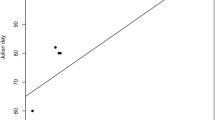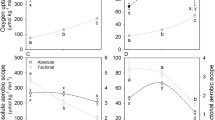Abstract
Among amphibians, the ability to compensate for the effects of temperature on the locomotor system by thermal acclimation has only been reported in larvae of a single species of anuran. All other analyses have examined predominantly terrestrial adult life stages of amphibians and found no evidence of thermal acclimatory capacity. We examined the ability of both tadpoles and adults of the fully aquatic amphibian Xenopus laevis to acclimate their locomotor system to different temperatures. Tadpoles were acclimated to either 12 °C or 30 °C for 4 weeks and their burst swimming performance was assessed at four temperatures between 5 °C and 30 °C. Adult X. laevis were acclimated to either 10 °C or 25 °C for 6 weeks and their burst swimming performance and isolated muscle performance was determined at six temperatures between 5 °C and 30 °C. Maximum swimming performance of cold-acclimated X. laevis tadpoles was greater at cool temperatures and lower at the highest temperature in comparison with the warm-acclimated animals. At the test temperature of 12 °C, maximum swimming velocity of tadpoles acclimated to 12 °C was 38% higher than the 30 °C-acclimation group, while at 30 °C, maximum swimming velocity of the 30 °C-acclimation group was 41% faster than the 12 °C-acclimation group. Maximum swimming performance of adult X. laevis acclimated to 10 °C was also higher at the lower temperatures than the 25 °C acclimated animals, but there was no difference between the treatment groups at higher temperatures. When tested at 10 °C, maximum swimming velocity of the 10 °C-acclimation group was 67% faster than the 25 °C group. Isolated gastrocnemius muscle fibres from adult X. laevis acclimated to 10 °C produced higher relative tetanic tensions and decreased relaxation times at 10 °C in comparison with animals acclimated to 25 °C. This is only the second species of amphibian, and the first adult life stage, reported to have the capacity to thermally acclimate locomotor performance.
Similar content being viewed by others
Author information
Authors and Affiliations
Additional information
Accepted: 28 October 1999
Rights and permissions
About this article
Cite this article
Wilson, R., James, R. & Johnston, I. Thermal acclimation of locomotor performance in tadpoles and adults of the aquatic frog Xenopus laevis . J Comp Physiol B 170, 117–124 (2000). https://doi.org/10.1007/s003600050266
Issue Date:
DOI: https://doi.org/10.1007/s003600050266




